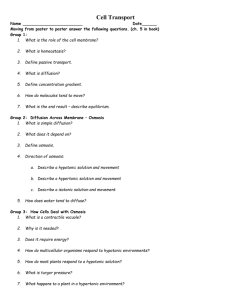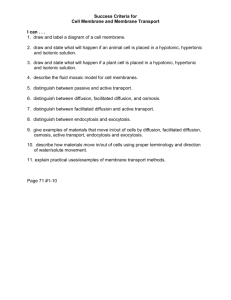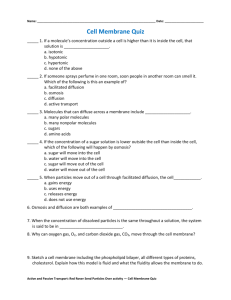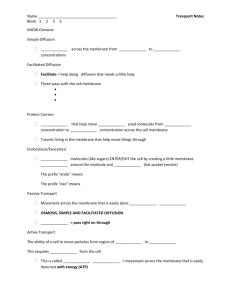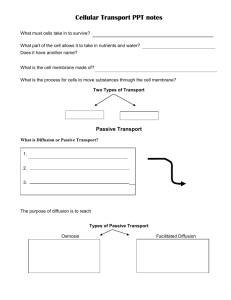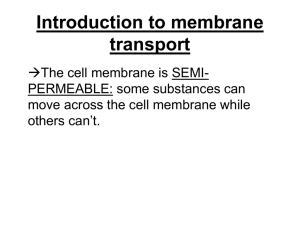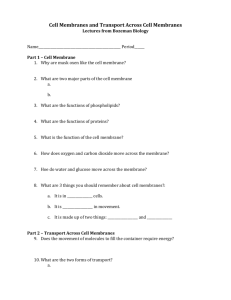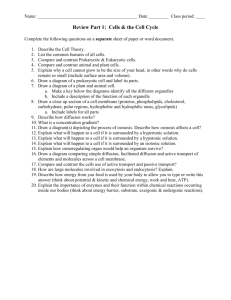Concept Presentation Summary - bourre-chem-11
advertisement
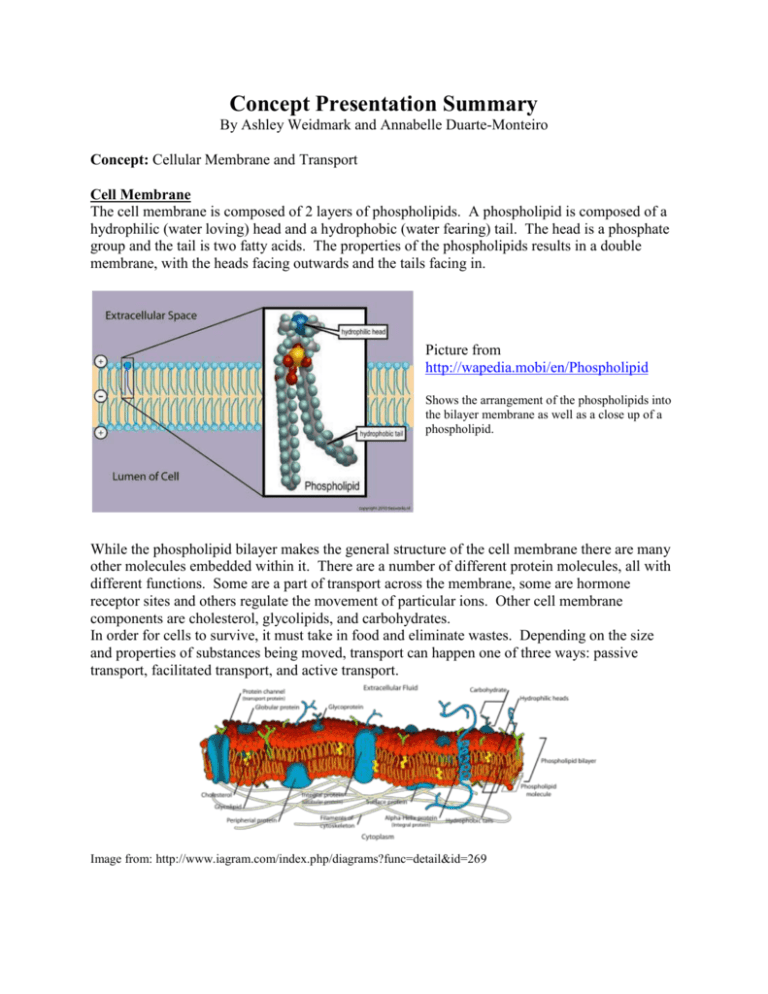
Concept Presentation Summary By Ashley Weidmark and Annabelle Duarte-Monteiro Concept: Cellular Membrane and Transport Cell Membrane The cell membrane is composed of 2 layers of phospholipids. A phospholipid is composed of a hydrophilic (water loving) head and a hydrophobic (water fearing) tail. The head is a phosphate group and the tail is two fatty acids. The properties of the phospholipids results in a double membrane, with the heads facing outwards and the tails facing in. Picture from http://wapedia.mobi/en/Phospholipid Shows the arrangement of the phospholipids into the bilayer membrane as well as a close up of a phospholipid. While the phospholipid bilayer makes the general structure of the cell membrane there are many other molecules embedded within it. There are a number of different protein molecules, all with different functions. Some are a part of transport across the membrane, some are hormone receptor sites and others regulate the movement of particular ions. Other cell membrane components are cholesterol, glycolipids, and carbohydrates. In order for cells to survive, it must take in food and eliminate wastes. Depending on the size and properties of substances being moved, transport can happen one of three ways: passive transport, facilitated transport, and active transport. Image from: http://www.iagram.com/index.php/diagrams?func=detail&id=269 Passive Transport Passive transport is the movement of materials across the cell membrane without any energy being used. Passive transport can be further divided into three types: diffusion, osmosis, and facilitated diffusion. Diffusion- diffusion is the movement of particles from an area of high concentration to an area of lower concentration in an attempt to equalize it. This form of transport does not use any of the cells energy but can only be used for small non-polar molecules. The oxygen and carbon dioxide in your blood uses this form of cellular transport. Osmosis – osmosis is similar to diffusion but in osmosis it is the water that is diffusing across a selectively permeable membrane. Osmosis occurs when there is a concentration gradient but due to a selectively permeable membrane the particles cannot cross, so the water diffuses across instead. The water moves to an area of low concentration to an area of higher concentration. To prevent too much water moving in or out of the cell it is important that the cell remains in an isotonic environment, which means that the concentrations inside and outside the cell are the same. If the cells are in a hypertonic solution (greater concentration outside the cell) then water will diffuse out of the cell causing the cell to collapse. On the other hand if the cells are in a hypotonic solution (greater concentration inside the cell) then water will diffuse into the cell causing it to swell and possibly burst. Facilitated Diffusion Facilitated diffusion, another form of passive transport, is when the molecules move with the concentration gradient but move through a “tunnel” in the membrane called a carrier protein. It is believed that facilitated diffusion is a way to speed up transport of particles across the membrane. Since the movement of particles is going with the concentration gradient the energy does not need to use any energy. Active Transport Active transport is when particles move against the concentration gradient and therefore requires energy from the cell to be used. Endocytosis is a form of active transport bringing molecules too big for transport carrier molecules, into the cell. Pinocytosis is a form of endocytosis, where the cell ingests dissolved molecules by engulfing some of its surrounding liquid. Phagocytosis, the other form of endocytosis, is when the cell engulfs solid material. Exocytosis is the other form of active transport and is how the cell eliminates most of its waste. Image from: http://www.mhhe.com/biosci/esp/2001_gbio/folder_structure/ce/m3/s4/ Lesson Concept Learning Expectations Teaching/ Learning Strategies Assessment/Eva luation 1 Cellular Membranes: Intro: Hook: Video on Fluid Mosaic Model http://www.youtube.com/watch?v=LKN5sq5dtW4 Read pp. 68-70 and Complete Review Questions: pp. 71 (Carter-Edwards, Trent, Susanne Gerards et al. Biology 12. 2011 ed. Toronto: McGraw-Hill Ryerson, 2011. Print.) Define Key terms pp. 72 (Carter-Edwards, Trent, Susanne Gerards et al. Biology 12. 2011 ed. Toronto: McGraw-Hill Ryerson, 2011. Print.) Passive Transport 1: Complete Diffusion Activity (Gizmo) http://www.explorelearning.com/index.cfm?method=cReso urce.dspView&ResourceID=417 and student exploration sheet http://cs.explorelearning.com/materials/DiffusionSE.pdf Complete Osmosis Activity (Gizmo) http://www.explorelearning.com/index.cfm?method=cReso urce.dspView&ResourceID=418 and student exploration sheet http://cs.explorelearning.com/materials/OsmosisSE.pdf Osmosis demonstration with potatoes http://www.youtube.com/watch?v=i0epq8J_K5k&feature=r elated B3.6 -Video -Text questions -Anecdotal notes of student work and comprehension B3.6 -Osmosis Gizmo -Worksheet -Diffusion Gizmo -Worksheet -Demonstration -Assess worksheets 3 Passive Transport 2: Review of 3 types of Passive Transport i.e. Simple Diffusion, Osmosis, Facilitated diffusion (channel proteins and carrier proteins) http://www.zerobio.com/flashmx/transport.swf Lab: http://library.thinkquest.org/27819/transport_across_a_mem brane_lab.html OR Lab http://www.mrsec.psu.edu/museum/biology/procedures/me mbranes.pdf B2.2, B2.5 -Lab -Lab Report -Rubric 4 Active Transport: Read pp. 75-77 Complete Learning Check pp. 77 # 31-36 (Carter-Edwards, Trent, Susanne Gerards et al. Biology 12. 2011 ed. Toronto: McGraw-Hill Ryerson, 2011. Print.) Membrane Assisted Transport: Endocytosis/Exocytosis: http://www.maxanim.com/physiology/Endocytosis%20and %20Exocytosis/ee4.swf Review B3.6 -Text Questions -T-ChartCompare various transport systems -Checklist -Assess T-Chart 2 Special Materials: -projector -computers with Gizmos program -if you do the demonstrations you will also need -2 peeled potatoes (one boiled and one raw) -2 petri dishes -knife -salt -water Student difficulties Students can have difficulties trying to think of these processes at the molecular level so a lot of animations can help them to better visualize and understand what is happening. Students have a hard time differentiating between the process of osmosis and diffusion. The use of interactive activities (Gizmos) and demonstrations will help them to differentiate between the two. With diffusion, students believe that once the molecules are evenly spread out that they stop moving. Exocytosis is the same as active transport. Teaching ideas Lots of animations! o Diffusion o Osmosis o Facilitated Transport o Active Transport Interactive web sites o Gizmos o The Molecular Workbench Database of Curriculum, Models and Activities Drama o Have students physically get up and move to demonstrate the different transport systems Demonstrations o To illustrate the concept of osmosis Evaluation Strategies Teacher can view the questions answered on the Gizmo for “as learning” assessment. Lab report can be assessed for Knowledge and Understanding, Communication and ability to Make Connections. Students can make a model of a membrane that will demonstrate not only the structure of a cell membrane but also the different forms of transport (facilitated, passive and active transport). The model does not need to be 3D but should show movement across the membrane (ie. they could use felt and Velcro to allow pieces to be moved around). Paper and pencil assessment Practical Applications and Societal Implications Students will understand how gases such as oxygen and carbon dioxide move in and out of blood. Students will understand the implication of certain poisons affecting transport channels and how that can affect the body’s electrical impulses. Annotated Internet Addresses http://workbench.concord.org/database/activities/321.html This site has an interactive lesson on diffusion, osmosis and active transport. It helps students to see how these forms of transport work step by step, with questions along the way to assess understanding. Very clear, easy to use, and it illustrates the concepts in a way students are sure to understand. http://serendip.brynmawr.edu/sci_edu/waldron/ This site provides dozens of hands on experiments to do with a senior biology class. For each experiment there is a student handout as well as teacher preparation notes. In the student worksheet the procedure is explained and has a number of questions for the students to answer. The teacher notes gives background information, detailed instructions on how to prepare for the lab, possible alternatives, as well as additional questions to ask the students. http://www.explorelearning.com/ Gizmos is a site that allows students to explore interactive lessons about a variety of science topics ranging from Grade 3-12. It is a very easy site to use and really gives the students the chance to experiment with different variables. Every activity has questions that accompany it which can be accessed by the teacher for assessment. http://www.zerobio.com/flashmx/transport.swf This site is an animation of different transport systems across a cell membrane. It shows each transport system step by step with labels identifying key components. Very good animation to help students better understand cell transport.
